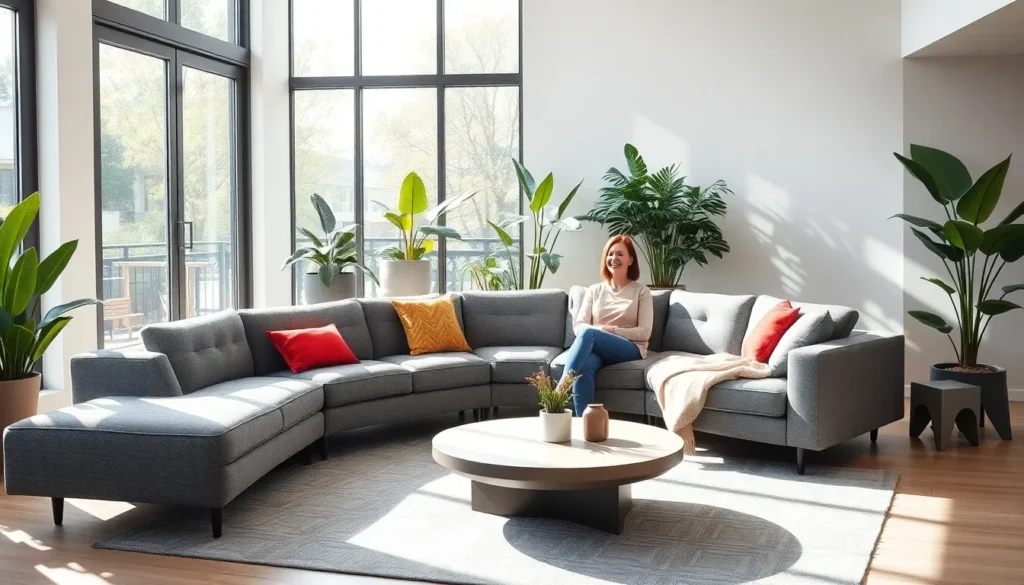We’re living in an era where contemporary design has transformed how we envision our living spaces. Today’s homeowners crave clean lines, functional beauty, and spaces that reflect their modern lifestyle while maintaining warmth and personality.
Contemporary living rooms blend minimalist aesthetics with comfortable functionality, creating environments that are both visually striking and livable. We’ve discovered that the best contemporary designs don’t just follow trends—they create timeless spaces that adapt to our evolving needs. From statement furniture pieces to strategic lighting choices, these rooms prove that modern doesn’t have to mean cold or impersonal.
Whether you’re starting from scratch or refreshing your current space, we’ll guide you through the essential elements that define contemporary living room design. You’ll learn how to balance simplicity with sophistication while creating a room that truly represents your personal style and enhances your daily life.
Embrace Clean Lines and Geometric Shapes
Contemporary living room design thrives on the precision of clean lines and the visual impact of geometric forms. These elements create the foundation for spaces that feel both sophisticated and effortlessly modern.
Streamlined Furniture Silhouettes
Selecting furniture with crisp edges transforms your living room into a contemporary showcase. We recommend choosing sofas with straight backs and square cushions rather than curved or rolled arms. Low-profile coffee tables with rectangular tops and minimal legs create visual breathing room while maintaining functionality. Platform beds, box-frame ottomans, and angular accent chairs contribute to the streamlined aesthetic.
Storage answers work best when they follow geometric principles. Built-in wall units with clean rectangular compartments eliminate visual clutter while providing necessary organization. Media consoles with sleek horizontal lines and hidden cable management keep technology integrated yet invisible. Floating shelves arranged in precise geometric patterns add storage without disrupting the room’s linear flow.
Modern lighting fixtures emphasize geometric shapes through pendant lights with cylindrical or cubic forms. Track lighting systems create clean horizontal lines across ceilings. Floor lamps with angular bases and rectangular shades complement the furniture’s streamlined silhouettes.
Bold Architectural Elements
Incorporating structural geometric features elevates contemporary living rooms beyond furniture arrangements. We suggest adding accent walls with vertical wood slats or horizontal metal panels to create striking linear patterns. Ceiling treatments using exposed beams in grid formations or coffered designs add architectural interest without compromising the clean aesthetic.
Window treatments emphasize geometric shapes through floor-to-ceiling panels that create strong vertical lines. Motorized blinds with precise horizontal slats control light while maintaining the room’s structured appearance. Large picture windows framed with minimal trim showcase outdoor views as living artwork.
Fireplace surrounds benefit from geometric redesigns using materials like concrete, steel, or stone arranged in rectangular patterns. Linear gas fireplaces create horizontal focal points that anchor seating arrangements. Built-in entertainment centers with precise rectangular cutouts integrate technology seamlessly into the room’s geometric framework.
Room dividers using geometric screens or partition walls define spaces without blocking light flow. These elements feature repeated patterns like hexagons, triangles, or interlocking rectangles that add visual texture while maintaining the contemporary aesthetic.
Incorporate a Neutral Color Palette With Strategic Pops of Color
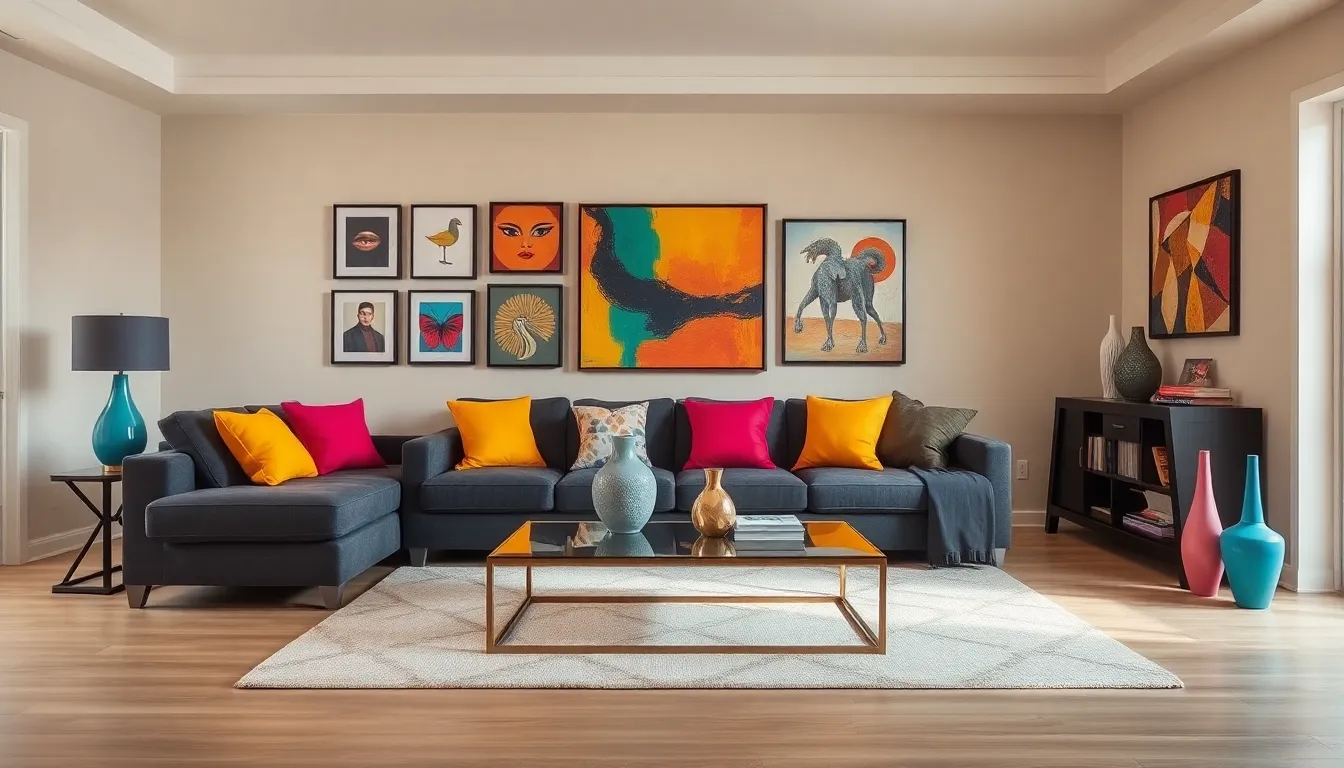
Building on the foundation of clean lines and geometric elements, we find that contemporary living rooms truly shine when they embrace a balanced approach to color. The key lies in establishing a neutral base while strategically introducing vibrant accents that energize the space without overwhelming its sophisticated aesthetic.
Monochromatic Base Schemes
Neutral foundations create the perfect canvas for contemporary living room design. Shades like beige, gray, and cream provide a versatile backdrop that allows other design elements to take center stage. We recommend choosing one neutral tone and exploring its various depths throughout the room.
Monochromatic schemes involve using different shades of the same color family. This approach creates a cohesive and harmonious environment that feels intentional and polished. Varying the intensity of your chosen neutral adds visual interest while maintaining the clean aesthetic contemporary design demands.
Depth and dimension emerge naturally when you layer different tones. Light gray walls paired with charcoal furniture and silver accents demonstrate how a single color family can create complexity. The result is a space that feels sophisticated yet welcoming, embodying the perfect contemporary balance.
Accent Colors Through Art and Accessories
Strategic pops of color transform neutral spaces into ever-changing contemporary environments. We suggest introducing vibrant hues through carefully selected furniture pieces, area rugs, or decorative items that can easily be updated as trends evolve. A brightly colored accent chair or bold throw pillows can instantly energize your neutral foundation.
Artwork serves as an ideal vehicle for incorporating accent colors without permanent commitment. Gallery walls featuring colorful pieces allow you to experiment with different palettes while maintaining design flexibility. Vases, sculptures, and other decorative accessories offer additional opportunities to introduce strategic color moments.
Balancing accent colors with neutral elements ensures your contemporary living room maintains its sophisticated atmosphere. We recommend following the 60-30-10 rule: 60% neutral base, 30% secondary neutral, and 10% bold accent color. This proportion creates visual harmony while allowing your strategic color choices to make the intended impact.
Choose Statement Lighting as Functional Art
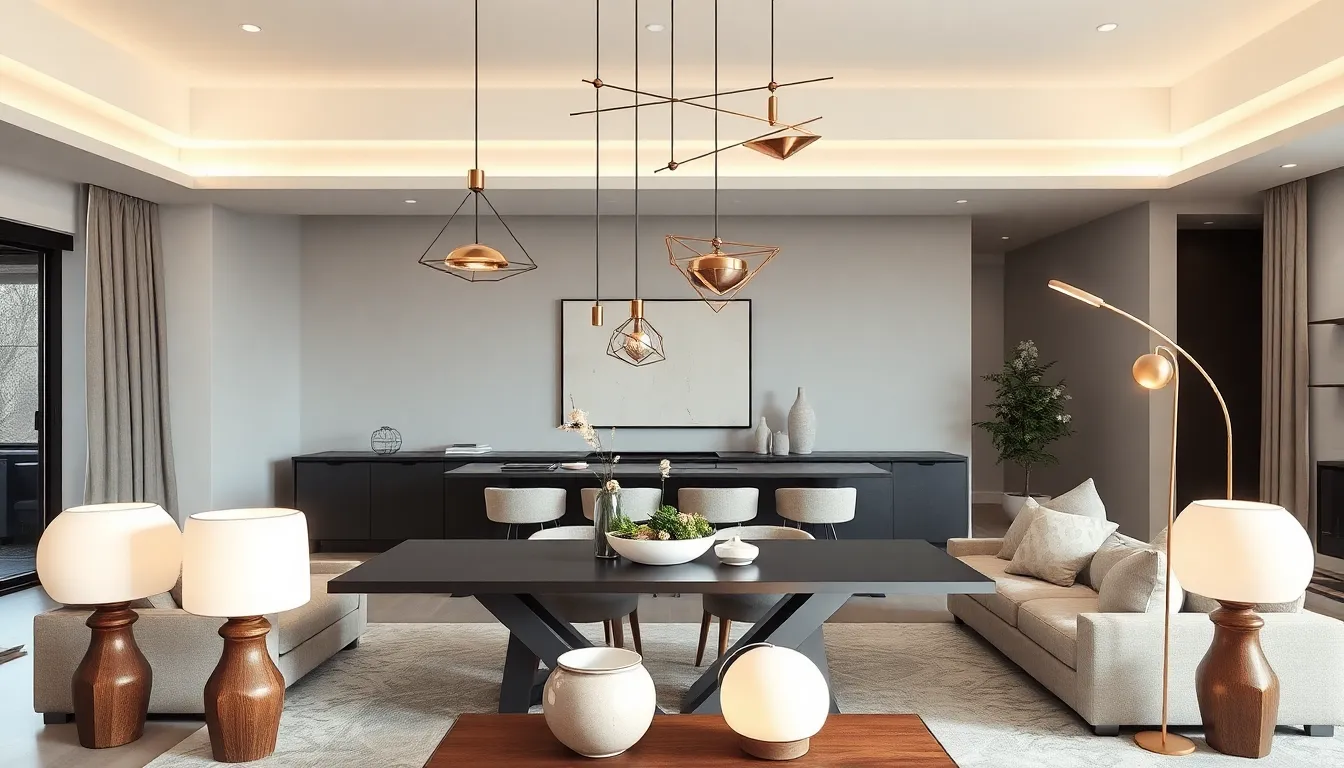
Contemporary lighting fixtures transform functional illumination into captivating design elements that elevate our living spaces. When we select lighting as functional art, we’re investing in pieces that serve dual purposes while creating stunning visual impact.
Sculptural Pendant Lights
Sculptural pendant lights feature unique shapes and artistic elements that command attention in contemporary living rooms. These striking fixtures often showcase geometric forms, organic curves, or metallic finishes that complement our modern aesthetic. We can hang oversized pendant lights above dining areas or kitchen islands in open plan spaces to establish dramatic focal points.
Functionality meets artistry when pendant lights provide both ambient and task lighting. Multi bulb configurations allow us to adjust brightness levels throughout the day, creating intimate evening atmospheres or bright workspaces as needed. Popular materials include brushed brass, matte black steel, and handblown glass that enhance our neutral color schemes.
Placement strategies maximize visual impact while maintaining proper proportions. We recommend hanging pendant lights 30 to 36 inches above dining surfaces and ensuring the fixture width measures one half to two thirds of the table width. Clustered arrangements of varying heights create ever-changing compositions that draw the eye upward.
Modern Floor and Table Lamps
Modern floor and table lamps showcase sleek minimalist designs that complement contemporary furniture arrangements. Arc floor lamps with adjustable heads provide targeted reading light while their sculptural bases serve as artistic statements. Tripod designs and cylindrical forms offer clean silhouettes that don’t overwhelm our carefully curated spaces.
Strategic lamp placement creates layered lighting schemes that enhance functionality and ambiance. We position floor lamps in corners to soften harsh angles and add warmth to seating areas. Table lamps on console tables and side tables provide intimate lighting for evening conversations while highlighting decorative objects and artwork.
Contemporary lamp materials include natural wood bases, ceramic forms, and metal finishes that coordinate with our existing hardware. LED compatibility ensures energy efficiency while dimmer switches allow us to control mood lighting throughout different times of day. Fabric drum shades and linen cylinders diffuse light evenly while maintaining the clean aesthetic we desire.
Select Multi-Functional Furniture for Smart Living
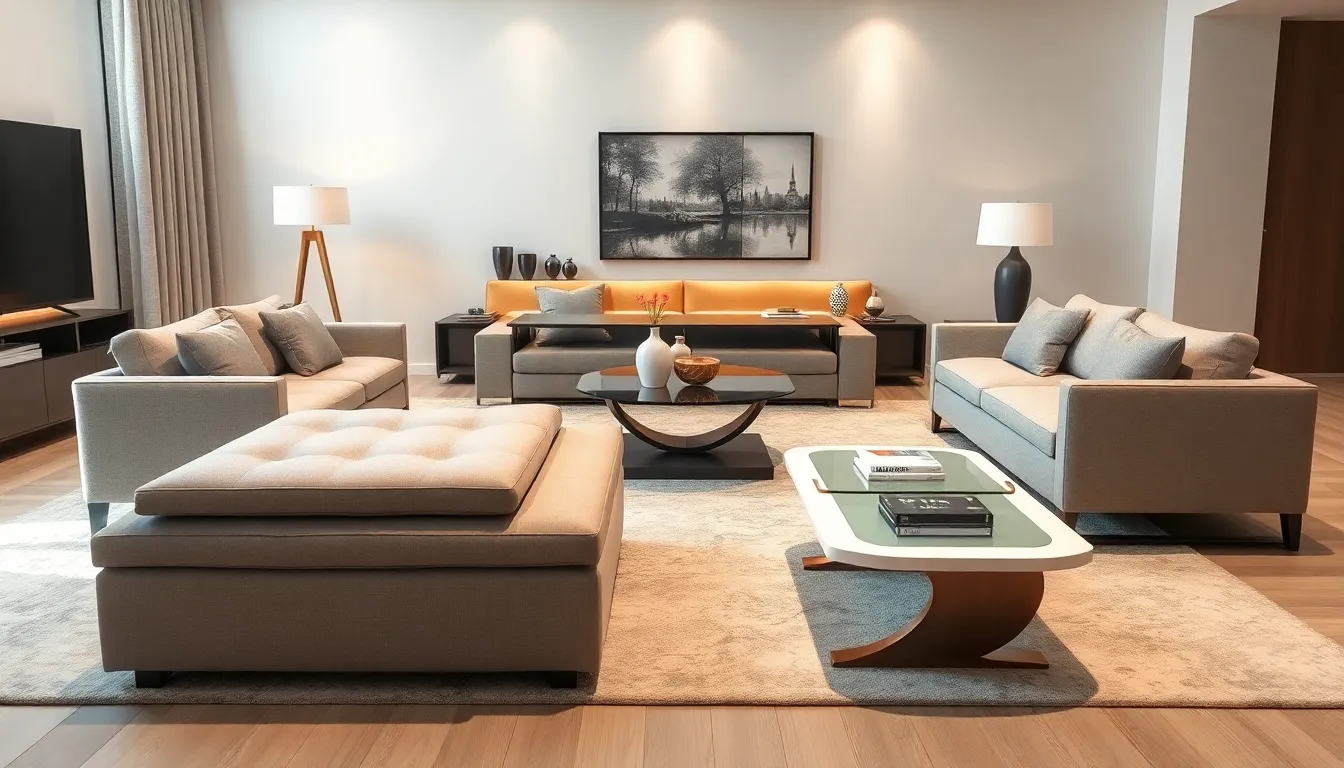
Smart furniture choices maximize both space and functionality while maintaining the clean aesthetic we’ve established through geometric design, neutral palettes, and statement lighting.
Ottoman Storage Answers
Ottoman storage answers transform traditional seating into dual-purpose powerhouses that enhance our contemporary living rooms. We can incorporate these versatile pieces to serve as additional seating while providing hidden storage for items like throw blankets, pillows, and books. Round ottomans soften the geometric lines of our furniture arrangement while maintaining clean design principles.
Storage capacity varies significantly across different ottoman styles. Large rectangular ottomans accommodate bulky items like seasonal bedding and extra cushions. Smaller cube ottomans work perfectly for organizing remotes, magazines, and charging cables. We recommend choosing ottomans with removable tops for easy access to stored items.
Material selection impacts both durability and aesthetic appeal. Upholstered ottomans in neutral fabrics blend seamlessly with our established color palette. Leather options add sophistication while remaining easy to clean. Woven textures introduce natural elements that complement our contemporary design approach.
Convertible Coffee Tables
Convertible coffee tables optimize space and functionality by doubling as desks or dining surfaces in smaller living rooms. We can select lift-top models that reveal hidden storage compartments while elevating the surface for comfortable laptop use or dining. These tables maintain the low profile furniture aesthetic while adapting to our changing daily needs.
Height adjustment mechanisms vary in quality and ease of use. Hydraulic systems provide smooth operation and support heavier loads. Spring-loaded mechanisms offer budget-friendly alternatives with reliable performance. We should test the adjustment mechanism before purchase to ensure smooth operation over time.
Surface materials should complement our existing furniture finishes. Glass tops create visual lightness and reflect our statement lighting fixtures. Wood surfaces add warmth while maintaining durability for daily use. Metal accents can echo the brushed brass elements in our lighting fixtures. Storage capacity within these tables accommodates everything from board games to work documents, keeping our living space organized and clutter-free.
Create Visual Interest With Mixed Textures and Materials
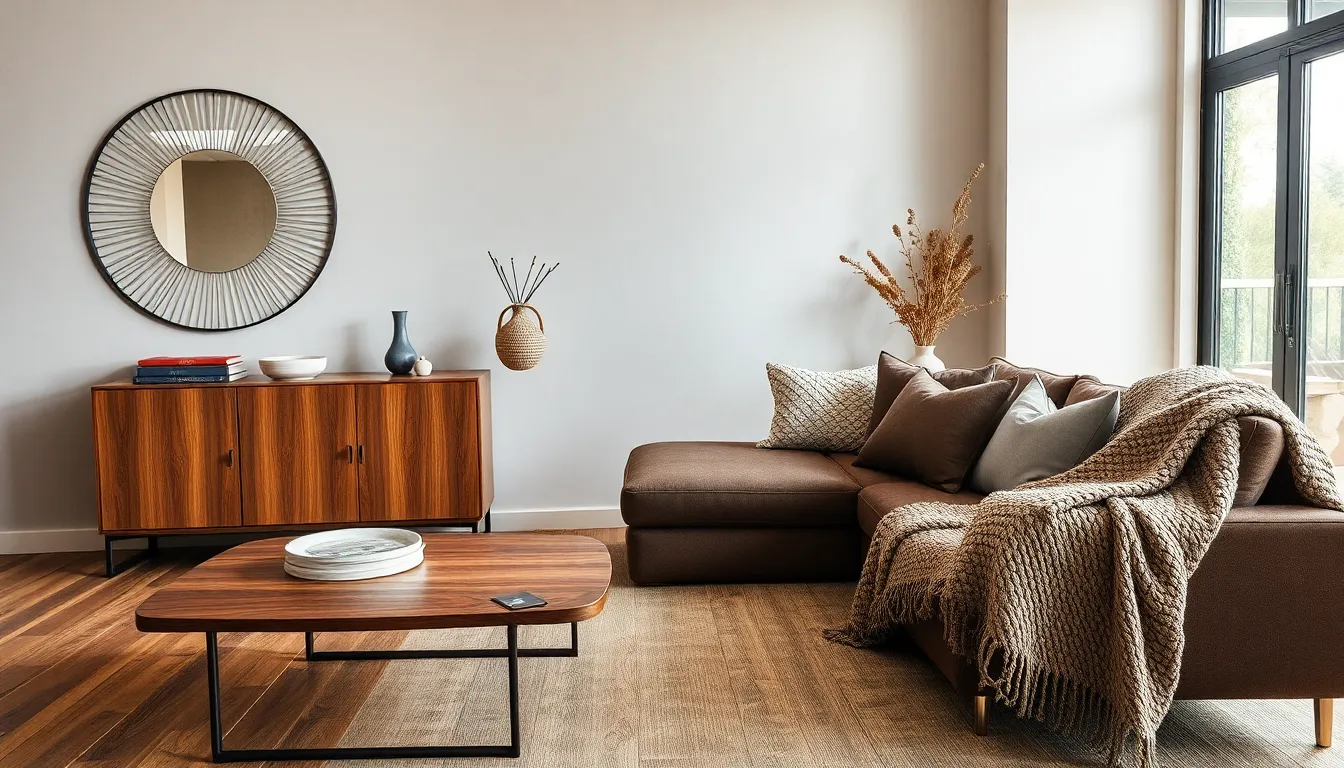
We achieve visual depth and sophistication by combining different textures and materials throughout our contemporary living spaces. This approach creates ever-changing focal points while maintaining the clean aesthetic that defines modern design.
Natural Wood and Metal Combinations
Pairing natural wood with metal elements creates a harmonious blend of organic warmth and industrial sophistication. We recommend selecting pieces that showcase both materials in equal measure, such as a wooden coffee table featuring sleek metal legs or a reclaimed wood console paired with brushed steel hardware.
Consider incorporating metal framed mirrors above wooden furniture pieces to establish visual balance. The contrast between warm wood tones and cool metal finishes adds dimensional interest without overwhelming the space. We’ve found that mixing different wood grains with various metal finishes like brass, copper, or matte black creates unique personality in each room.
Structural elements offer another opportunity to blend these materials effectively. Wooden floating shelves supported by metal brackets or metal-framed room dividers with wooden accents serve dual purposes as functional storage and design statements.
Luxurious Fabric Layering
Layer different fabric textures to enhance both comfort and visual appeal throughout your seating areas. We suggest combining velvet throw pillows with linen upholstery and adding cashmere or wool blankets in complementary tones. This creates tactile richness that invites relaxation while maintaining contemporary sophistication.
Mixing fabric weights and weaves adds depth to your color palette. Pair smooth leather seating with nubby bouclé accent pillows, or combine silk curtains with jute area rugs for contrast. We recommend selecting fabrics within your established neutral palette, using texture rather than color to create visual interest.
Strategic placement of luxurious textiles creates cozy focal points within minimalist spaces. Drape a chunky knit throw over one corner of your sectional, or cluster pillows in varying textures on a streamlined sofa. These additions provide warmth and personality without disrupting the clean lines that define contemporary design.
Maximize Natural Light and Open Space Flow

We’re transforming contemporary living rooms by focusing on two key elements that create an expansive and bright environment. Natural light becomes our most powerful design tool when we maximize its potential through strategic architectural choices.
Floor-to-Ceiling Windows
Floor to ceiling windows stand as the premier choice for contemporary living rooms seeking maximum natural light impact. These expansive glass installations offer uninterrupted views while creating seamless transitions between indoor and outdoor spaces. We recommend selecting thin window frames to increase the glass surface area and enhance light penetration throughout the room.
Installing these dramatic windows transforms any living space into a bright sanctuary that feels connected to nature. Contemporary homeowners particularly value how floor to ceiling installations eliminate visual barriers and make rooms appear significantly larger. The continuous glass surface creates an architectural statement that defines modern living while flooding interiors with abundant daylight.
Strategic placement of these windows works best on south facing walls where we can capture optimal sun exposure throughout the day. We suggest pairing floor to ceiling installations with automated shading systems to control brightness levels and maintain comfortable temperatures. The investment in quality window systems pays dividends through reduced lighting costs and enhanced property values.
Strategic Mirror Placement
Strategic mirror placement amplifies natural light from windows while creating powerful illusions of expanded space in contemporary living rooms. We position mirrors directly opposite or adjacent to major light sources to reflect and multiply brightness throughout the room. Large mirrors work exceptionally well as they capture more light and create dramatic spatial effects.
Mirrors become functional design elements that serve dual purposes in our contemporary lighting strategy. We recommend oversized mirrors with sleek frames that complement existing metallic accents and maintain clean aesthetic lines. Positioning mirrors at angles allows us to direct light into darker corners and create ever-changing lighting patterns that change throughout the day.
The reflection effect doubles visual space while improving the room’s brightness without additional electrical lighting. We strategically place mirrors near seating areas to create intimate conversation zones that feel open and airy. Contemporary mirror designs with geometric shapes reinforce our established design principles while maximizing their light reflecting capabilities.
Combining mirrors with floor to ceiling windows creates layered lighting effects that transform ordinary rooms into luminous contemporary showcases. We achieve optimal results by balancing mirror sizes and positions to avoid overwhelming reflections while maintaining sophisticated visual flow.
Display Contemporary Art and Sculptural Pieces
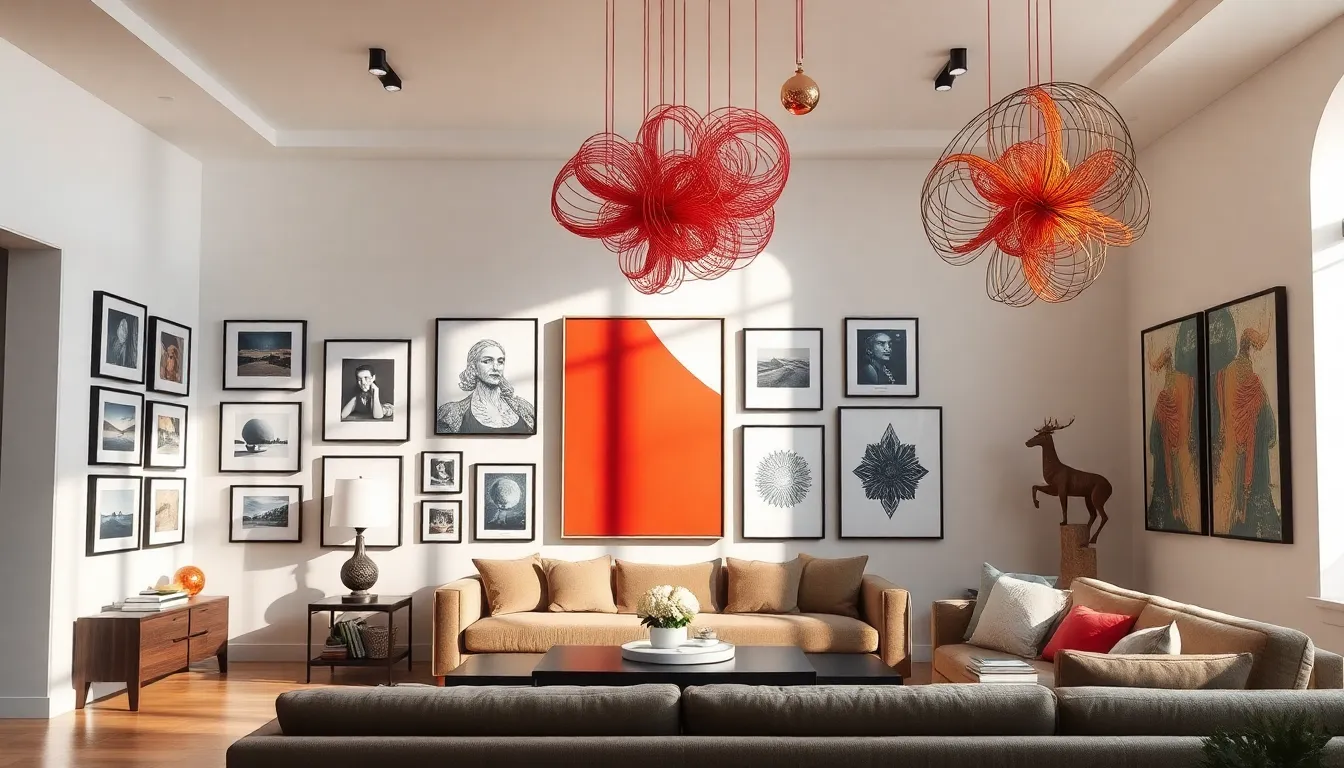
Contemporary art and sculptural elements transform living rooms into personalized galleries that reflect individual style while maintaining clean design principles. These artistic features serve as sophisticated focal points that elevate the space beyond basic furniture arrangements.
Gallery Wall Arrangements
Gallery walls offer versatile answers for showcasing personal collections while creating visual impact in contemporary living rooms. We recommend grouping various framed pieces such as photographs, prints, and artworks to establish a cohesive display that reflects your unique aesthetic preferences. Strategic spacing between frames maintains the clean lines essential to contemporary design while allowing each piece to contribute to the overall composition.
Frame selection plays a crucial role in achieving gallery wall success. Choose consistent frame styles in materials like brushed metal or sleek wood that complement your existing furniture and lighting fixtures. Varying sizes within the same frame family creates ever-changing visual interest without disrupting the sophisticated atmosphere you’ve established through neutral color palettes and geometric shapes.
Layout planning ensures professional results when installing gallery walls. Start by arranging pieces on the floor to test different configurations before committing to wall placement. Maintain consistent spacing of 2 to 3 inches between frames to create breathing room that supports the minimalist aesthetic while allowing artwork to shine as individual statements.
Three-Dimensional Art Installations
Three dimensional art installations add depth and sculptural interest that complements the multi functional furniture and mixed textures already present in contemporary living rooms. These installations range from suspended sculptures to intricate wall hangings that provide unique focal points without overwhelming the space’s clean aesthetic. Contemporary homeowners in 2025 increasingly favor sculptural furniture that doubles as art, improving both functionality and visual appeal.
Suspended installations work particularly well in spaces with high ceilings where they can interact with statement lighting fixtures to create layered visual experiences. Materials like metal, wood, and glass echo the mixed material approach used throughout contemporary design while adding vertical dimension that draws the eye upward. These pieces can complement natural light streaming through floor to ceiling windows by casting interesting shadows that change throughout the day.
Wall mounted sculptural pieces offer alternatives for spaces where suspended installations aren’t practical. These installations can incorporate organic elements that connect with the natural materials already present in your contemporary living room. Strategic placement near seating areas creates intimate viewing experiences while maintaining the open space flow essential to contemporary design principles.
Integrate Smart Technology Seamlessly
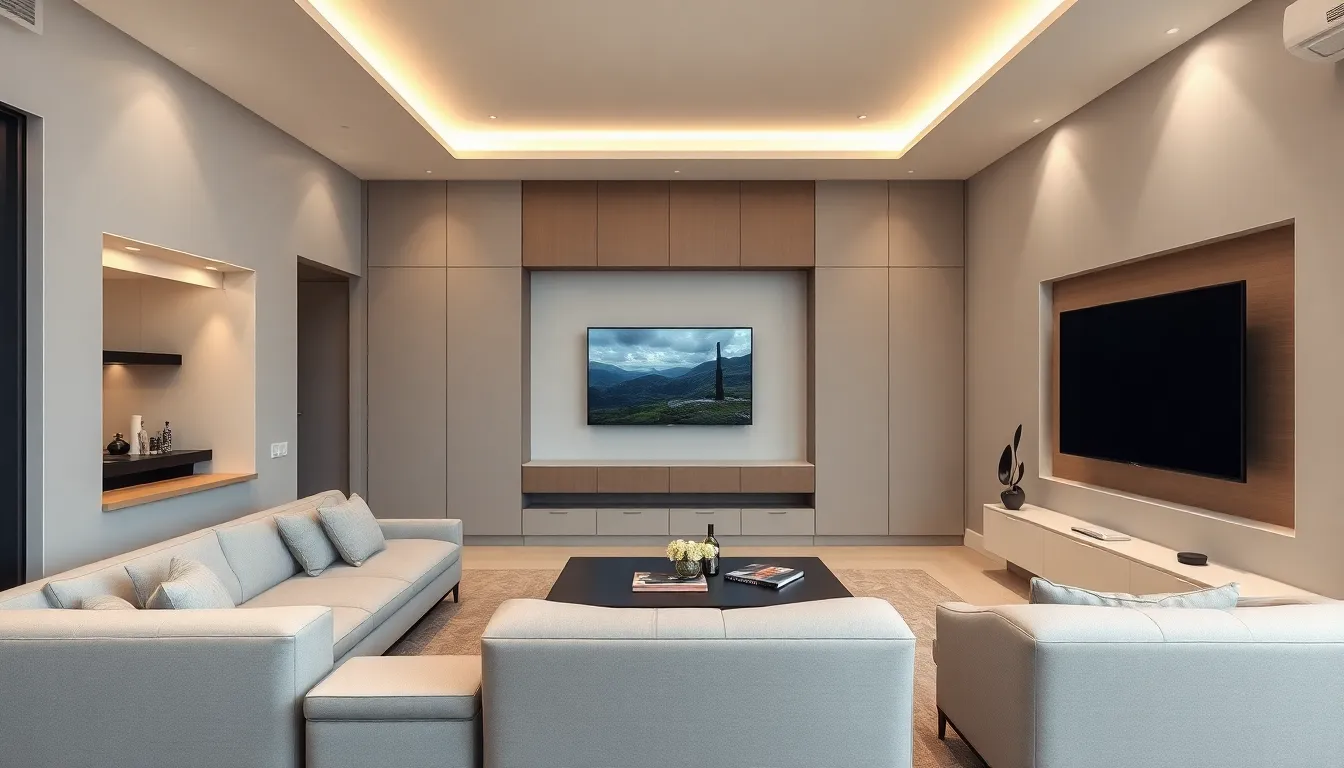
We’re transforming contemporary living rooms by incorporating smart technology that enhances functionality without compromising the clean aesthetic we’ve established. Built-in technology and pre-wired networks ensure our spaces remain adaptable to future advancements while maintaining visual harmony.
Hidden Entertainment Systems
Recessed installations eliminate visual clutter by concealing TVs and projectors within walls or using automated lifts that hide equipment when not in use. Wall-mounted displays disappear into custom millwork, while ceiling-mounted projectors drop down only during movie nights, preserving our room’s streamlined appearance.
Built-in speakers integrate seamlessly into kitchen cabinetry and bathroom mirrors, delivering high-quality audio without disrupting sight lines. In-wall and in-ceiling installations create immersive sound experiences while maintaining the geometric principles we’ve emphasized throughout our design. These systems connect to central hubs hidden in dedicated equipment rooms, ensuring cables and components remain completely out of view.
Smart media consoles feature hidden compartments that store gaming systems, streaming devices, and sound bars behind sleek cabinet doors. Wireless charging surfaces built into these units eliminate cord clutter while keeping devices powered and accessible. Custom millwork conceals ventilation systems that prevent overheating, ensuring our technology performs optimally within enclosed spaces.
Automated Lighting Controls
Smart lighting answers respond to voice commands and smartphone apps, allowing us to adjust ambiance instantly based on mood or daily schedules. These systems can dim lights gradually during evening hours, brighten spaces for morning routines, and automatically adjust color temperatures throughout the day to support natural circadian rhythms.
Color coordination ensures smart switches and dimmers complement our established neutral palette by matching finishes to existing hardware and fixtures. Brushed brass smart switches pair beautifully with metallic accents we’ve incorporated, while matte black options enhance rooms with darker design elements. These coordinated finishes create visual continuity that reinforces our contemporary aesthetic.
Energy conservation becomes effortless through programmable schedules that automatically turn lights off in unoccupied rooms and adjust brightness based on available natural light. Motion sensors integrated into our lighting systems activate pathway illumination during nighttime hours, providing safety and convenience without disrupting the room’s peaceful atmosphere. Smart bulbs can reduce energy consumption by up to 75% compared to traditional incandescent options while lasting significantly longer.
Define Zones in Open-Concept Layouts
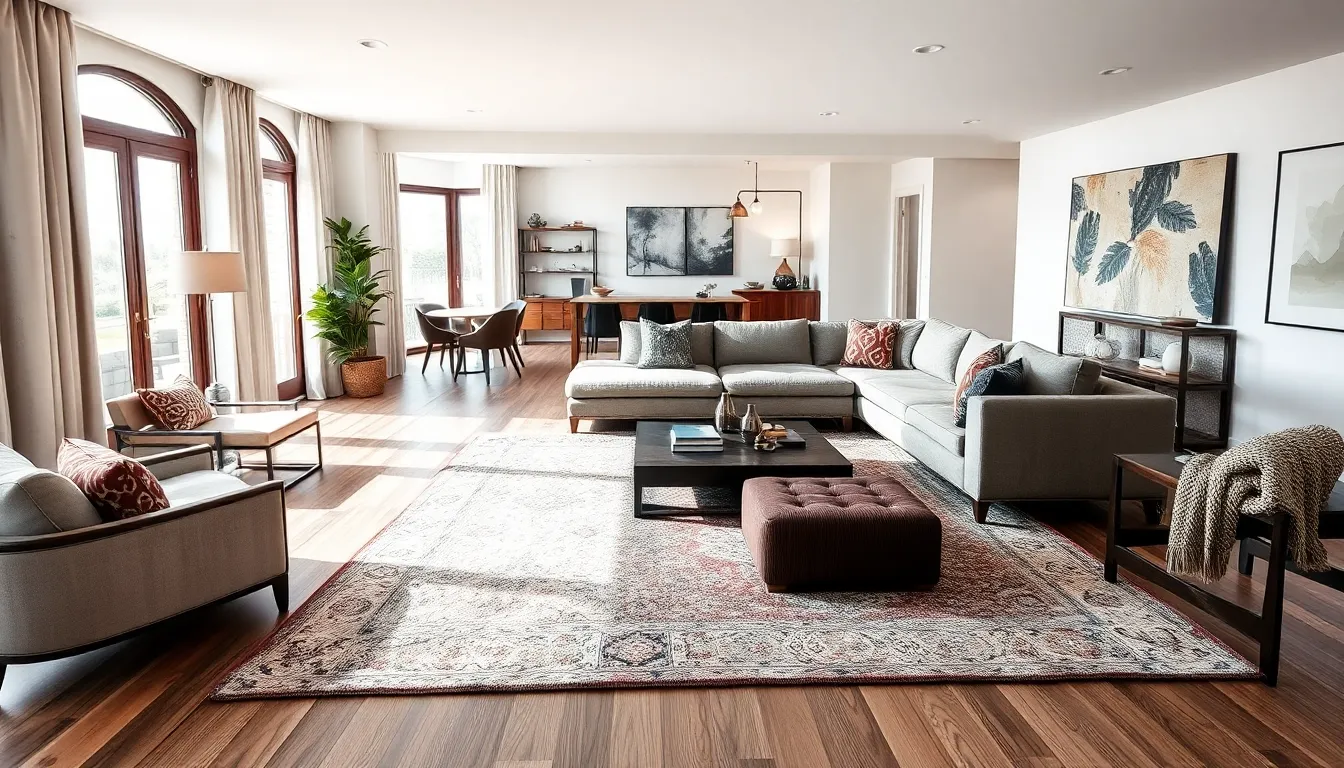
Open-concept living rooms require strategic zoning to maintain both functionality and visual appeal. We’ll explore two essential methods for creating distinct areas without compromising the spacious feel.
Area Rugs as Room Dividers
Area rugs serve as powerful visual dividers that define separate zones while adding warmth and texture to contemporary spaces. We recommend selecting rugs that complement your room’s existing color scheme, creating seamless transitions between different functional areas.
Size selection matters significantly when using rugs as dividers. Choose large rugs that extend at least 18 inches beyond your furniture groupings to establish clear boundaries. For example, place a 9×12 rug under your main seating arrangement and a smaller 6×9 rug in your reading nook.
Texture combinations enhance the zoning effect while maintaining contemporary aesthetics. Layer a jute or sisal rug as your base layer, then add a softer wool or cotton rug on top. This approach creates visual separation while providing comfortable surfaces for different activities.
Color coordination between multiple rugs prevents the space from feeling disjointed. Select rugs in varying shades of the same color family, or choose complementary patterns that share common hues with your furniture and decor.
Furniture Groupings for Function
Furniture groupings create natural boundaries in open concept layouts while serving exact purposes throughout your living space. We focus on three key approaches that maximize both form and function.
Sectional sofas offer the most versatile zoning solution for contemporary living rooms. Position modular sectionals to create conversation circles that naturally separate your main seating area from other zones like dining or work spaces. Choose pieces with clean lines and low profiles to maintain visual flow while establishing clear boundaries.
Multi-functional pieces serve dual purposes while defining zones effectively. Storage ottomans work as both seating for your entertainment zone and coffee tables for your conversation area. Similarly, console tables behind sofas create separation between living and dining areas while providing additional surface space and storage.
Curved furniture creates organic boundaries that feel less rigid than traditional room dividers. A curved sofa naturally forms a cozy seating area while its shape guides traffic flow around the space. Pair curved seating with round coffee tables to reinforce the soft zoning effect.
Strategic placement of these groupings considers traffic patterns and sight lines throughout your open concept space. Position your main furniture grouping to face away from work areas, creating psychological separation between relaxation and productivity zones. Leave at least 36 inches between different furniture groupings to maintain comfortable movement throughout the space.
Add Greenery With Modern Planters and Living Walls
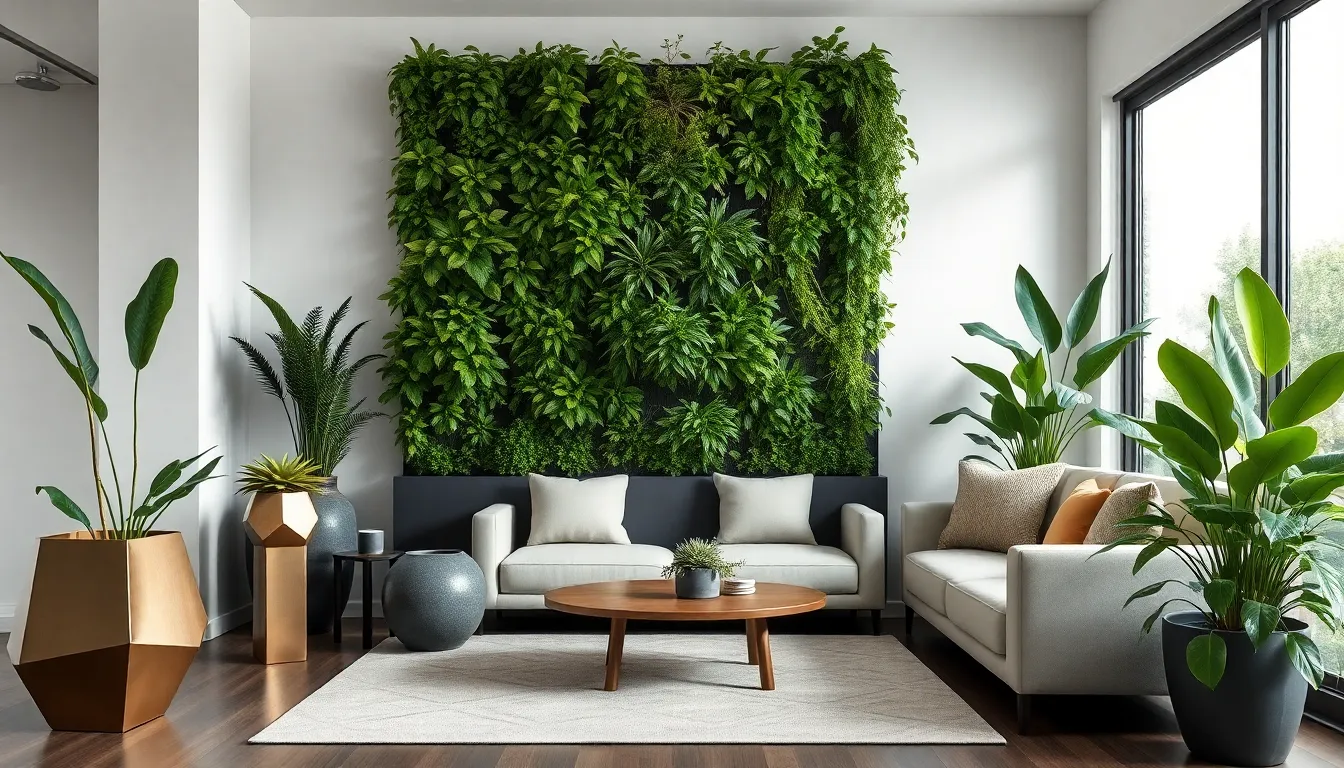
Contemporary living rooms thrive when nature meets sophisticated design through carefully chosen plant displays. We’ll explore how modern planters and vertical gardens transform your space while maintaining the clean aesthetic you’ve established.
Sculptural Plant Containers
Sculptural plant containers serve as stunning decorative pieces that elevate your contemporary living room beyond simple greenery. These containers function as modern art installations while housing your favorite plants, creating dual purpose focal points that complement your existing furniture arrangements.
Material selections make the biggest impact on your room’s overall aesthetic. We recommend choosing containers crafted from brushed metal, concrete, or geometric ceramic designs that echo the clean lines in your space. Matte black planters work exceptionally well with neutral color palettes, while brass accents coordinate beautifully with your statement lighting fixtures.
Size variations create visual rhythm throughout your living area. Large floor standing planters anchor seating arrangements, while medium sized containers work perfectly on side tables and media consoles. Small sculptural pieces add finishing touches to floating shelves and coffee table vignettes.
Plant pairings enhance the sculptural effect when matched thoughtfully with container styles. Angular planters showcase dramatic plants like snake plants or bird of paradise, while rounded vessels complement softer foliage such as fiddle leaf figs or monstera deliciosa.
Vertical Garden Features
Vertical garden features maximize your greenery impact while preserving valuable floor space in contemporary living rooms. These installations create stunning living artwork that connects your indoor space with natural elements.
Living wall systems transform blank walls into breathtaking green focal points. We suggest installing modular planting systems that allow easy plant rotation and maintenance access. These systems work particularly well behind sectional sofas or as room dividers in open concept layouts.
Mounting options provide flexibility for different wall types and rental situations. Freestanding vertical garden frames offer portability, while built in systems create seamless integration with your room’s architecture. Consider your ceiling height when selecting systems, as taller installations create more dramatic visual impact.
Plant selection determines your vertical garden’s success and maintenance requirements. Pothos, philodendrons, and air plants thrive in vertical arrangements with minimal care. Succulent varieties work beautifully in geometric patterns, while trailing plants like string of hearts create cascading effects that soften hard edges.
Irrigation answers keep your vertical gardens thriving without constant attention. Drip irrigation systems distribute water evenly throughout the installation, while self watering planters reduce maintenance time. These automated features align perfectly with the smart technology integration you’ve established throughout your contemporary space.
Conclusion
We’ve explored how contemporary living room design creates spaces that truly work for modern life. These principles transform any room into a sophisticated sanctuary that balances style with everyday functionality.
The key lies in thoughtful curation rather than following trends blindly. By combining clean lines with warm textures strategic lighting and smart technology we create environments that feel both current and timeless.
Remember that successful contemporary design reflects your personal style while maintaining those essential elements of simplicity and purpose. Start with one or two concepts that resonate most with your lifestyle and build from there.
Your living room should enhance how you live not constrain it. With these contemporary design strategies you’re equipped to create a space that’s both beautiful and genuinely livable for years to come.
Frequently Asked Questions
What defines contemporary living room design?
Contemporary living room design is characterized by clean lines, minimalist aesthetics, and functional beauty. It emphasizes geometric shapes, neutral color palettes, and the strategic use of natural light. The style focuses on creating sophisticated, uncluttered spaces that blend comfort with modern elegance while maintaining adaptability and timeless appeal.
How do I choose the right color palette for a contemporary living room?
Use a neutral base with shades like beige, gray, and cream as your foundation. Follow the 60-30-10 rule: 60% neutral base colors, 30% secondary neutrals, and 10% bold accent colors. This creates depth while maintaining the clean aesthetic. Add vibrant pops of color through artwork, rugs, and accessories for flexibility.
What type of furniture works best in contemporary design?
Select streamlined furniture with crisp edges and geometric shapes, such as straight-backed sofas and low-profile coffee tables. Choose multi-functional pieces like ottoman storage and convertible coffee tables to maximize space efficiency. Focus on quality materials and clean silhouettes that maintain the minimalist aesthetic while providing practical functionality.
How important is lighting in contemporary living rooms?
Lighting serves as both functional illumination and artistic statement pieces in contemporary design. Use sculptural pendant lights as focal points, complement with modern floor and table lamps, and create layered lighting schemes. Consider smart lighting controls for customizable ambiance and energy efficiency while maintaining the clean aesthetic.
How can I add texture without compromising the clean aesthetic?
Layer luxurious fabrics like velvet, linen, and cashmere through throw pillows, blankets, and upholstery. Combine natural wood with metal accents to create warmth and sophistication. Mix materials strategically to add visual interest while maintaining the geometric principles and clean lines characteristic of contemporary design.
What’s the best way to maximize natural light in contemporary spaces?
Install floor-to-ceiling windows with thin frames to maximize glass surface area and create seamless indoor-outdoor transitions. Use oversized mirrors with sleek frames to amplify existing light and create the illusion of expanded space. Position mirrors strategically to reflect natural light throughout the room for maximum brightness.
How do I incorporate art into contemporary living room design?
Create gallery wall arrangements with consistent frame styles and strategic spacing to maintain sophistication. Use three-dimensional installations like suspended sculptures or wall-mounted pieces to add depth without overwhelming the space. Choose artwork that complements your neutral palette while serving as personalized focal points.
Can I integrate smart technology without disrupting the design?
Yes, use hidden entertainment systems with recessed TV installations and built-in speakers to eliminate visual clutter. Choose smart media consoles that blend seamlessly with your furniture. Implement automated lighting controls through voice commands and smartphone apps to maintain the clean aesthetic while enhancing functionality and convenience.
How do I create zones in an open-concept contemporary living room?
Use large area rugs that extend beyond furniture groupings to establish clear boundaries and add warmth. Create natural divisions with sectional sofas and multi-functional furniture pieces. Ensure color coordination between zones and maintain comfortable movement paths to preserve the cohesive flow of the open space.
What’s the best way to add greenery to contemporary spaces?
Use sculptural planters in materials like brushed metal and geometric ceramics as decorative focal points. Vary planter sizes to create visual rhythm and choose plants that complement your design aesthetic. Consider vertical garden systems to maximize greenery while preserving floor space, and use automated irrigation for easy maintenance.

